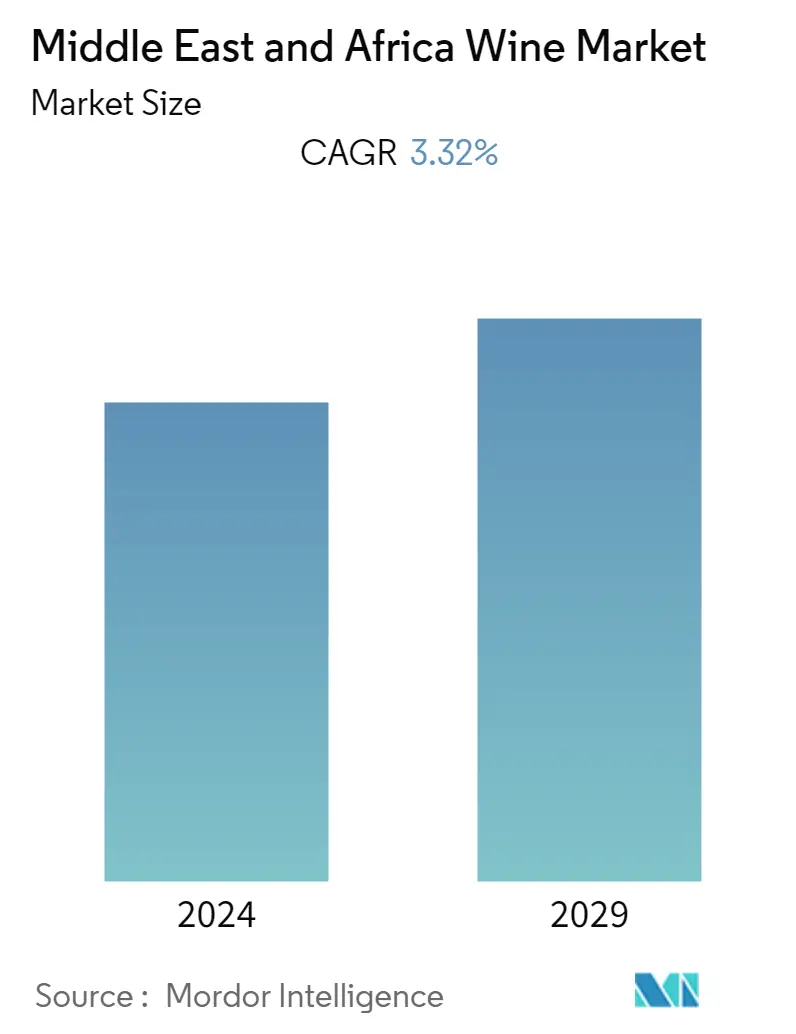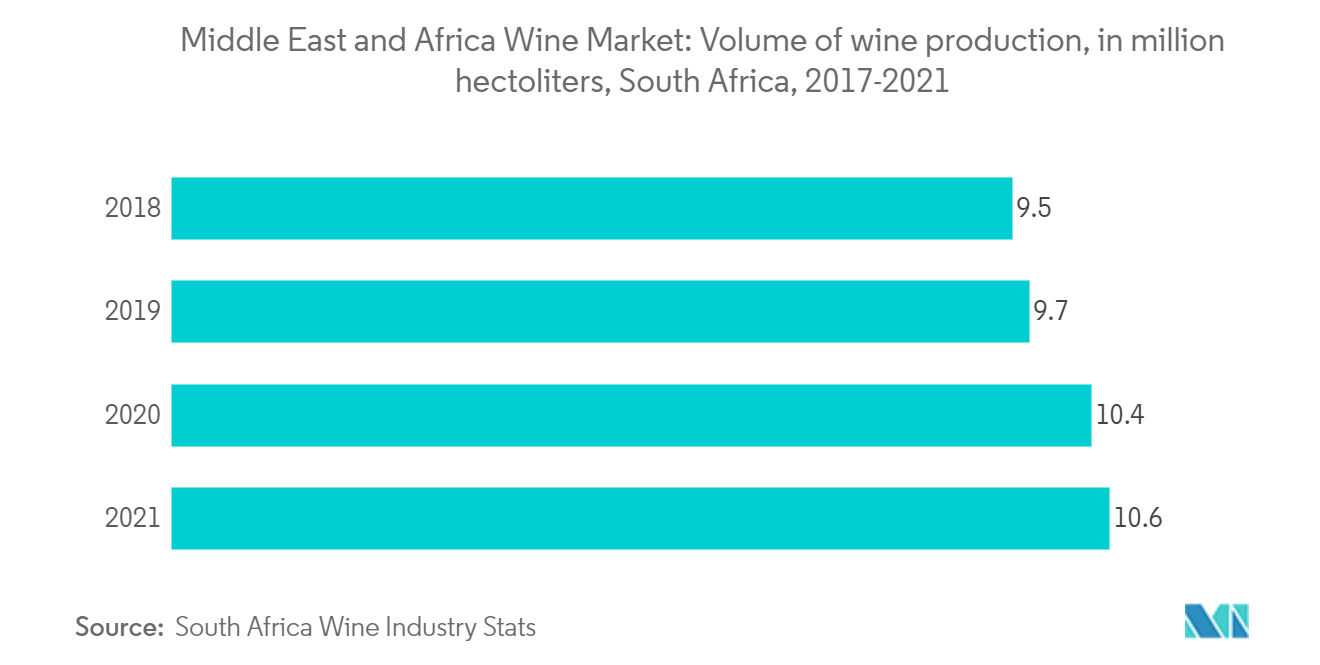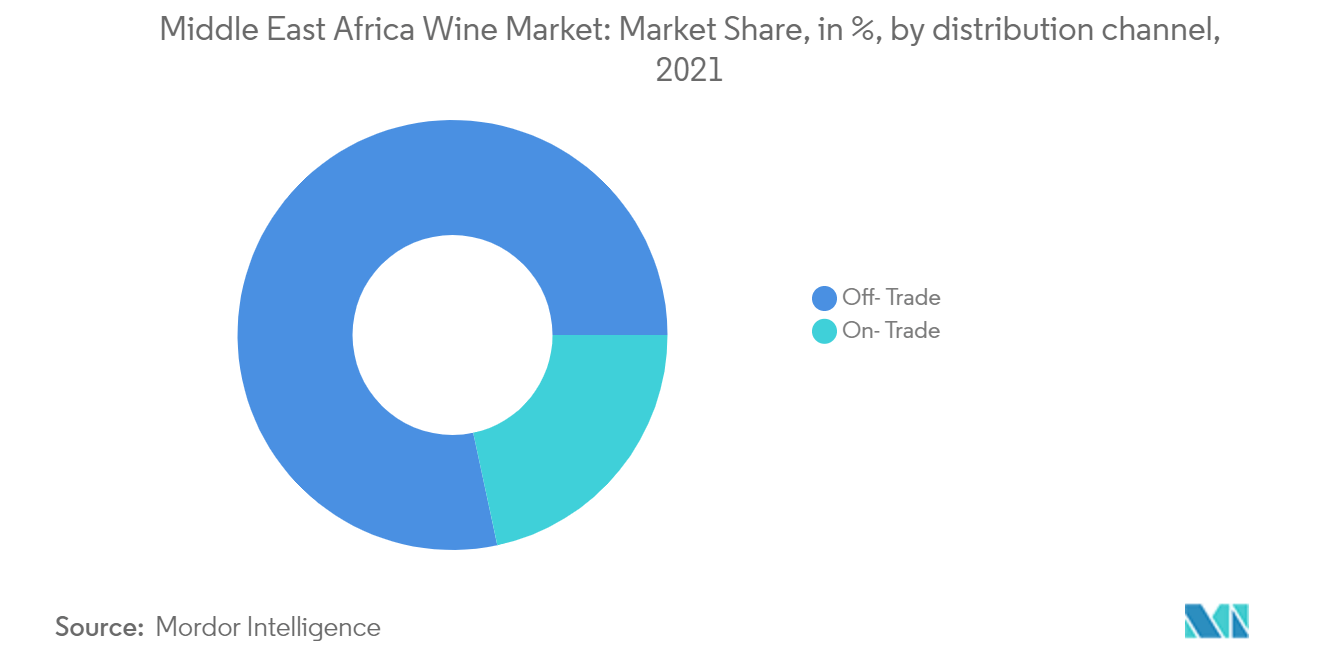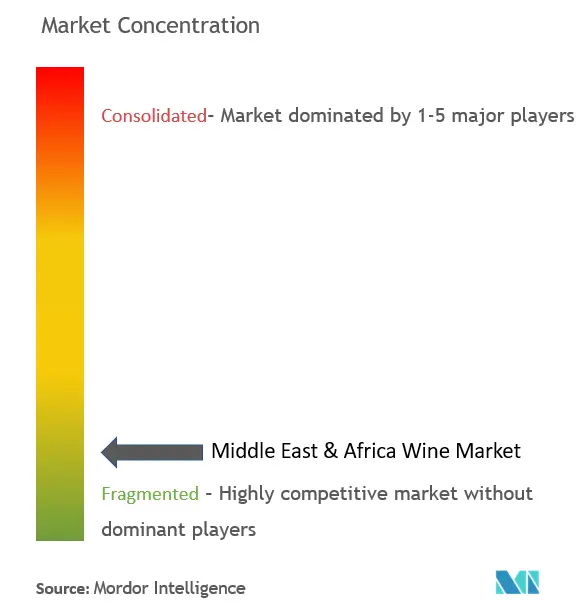Middle East Africa Wine Market Size

| Study Period | 2019 - 2029 |
| Base Year For Estimation | 2023 |
| Forecast Data Period | 2024 - 2029 |
| Historical Data Period | 2019 - 2022 |
| CAGR | 3.32 % |
| Market Concentration | Low |
Major Players
*Disclaimer: Major Players sorted in no particular order |
Middle East Africa Wine Market Analysis
The Middle East & Africa Wine Market is projected to register a CAGR of 3.32% during the forecast period, 2022-2027.
The pandemic has disrupted the global wine distribution channel due to the restrictions on hotels and restaurants worldwide. While the wine industry received permission to complete the wine grape harvest in 2020, South Africa's lockdown on local and international sales had far-reaching repercussions for the financial viability of businesses in the supply chain. According to a report by Wine International Association, in 2020, the South African wine industry lost around R450 million a week in local retail and international sales. Many farms also lost out on agritourism opportunities. With the assistance of the Bureau for Food and Agricultural Policy (BFAP), the industry estimated that an approximately 40% decrease in export value, around R9 billion, was observed during the prolonged lockdown.
Over the medium term, the wine market has witnessed significant growth, owing to the increasing demand for wine beverages with unique and refreshing flavors. Moreover, the increasing inclination toward premium white wine beverages is estimated to boost the wine market in the coming years.
The consumption of alcohol is becoming a sign of social status, supporting the growth of low-alcoholic or non-alcoholic wine in the market. It is gaining massive popularity among millennials and youngsters, owing to its claim of refreshment and low ABV offerings. It is associated chiefly with several occasions and served as a table wine with regular food in developing countries. This increasing demand further encourages manufacturers to launch and introduce innovative products in the market, indicating future market growth.
Middle East Africa Wine Market Trends
This section covers the major market trends shaping the MEA Wine Market according to our research experts:
Changing Lifestyle and Consumption Habits of Wine
In most countries, wine is considered a part of the diet, and in a few others, the consumption of wine is not encouraged. The reasons might be religious or health-related concerns. According to the World Health Organization, spirits are the most popular alcohol in the United Arab Emirates and Africa, followed by wine. Further, rising westernization in the country opens room for opportunities for wine market players as wine is considered in the premium category.
Most of the population belongs to the high-income group, and thus, they seek quality wine without any price barrier, thus propelling the market growth significantly. The younger generation has enthusiastically embraced sparkling wines, including, but not restricted to, champagne. This indicates that sparkling prosecco continues to expand its global reach, overtaking champagne. According to the United States Department of Agriculture (USDA) 2020 report, white wine grape varieties contribute 66% of the total wine grapes produced in South Africa. White wine varieties, such as Chenin Blanc, are the most widely grown white wine grape variety in South Africa.
Moreover, sparkling white wine is highly consumed among Arabians as compared to any other category because of the high popularity of Friday brunch with sparkling wine. Further, sighting the rising demand for wine in the United Arab Emirates, the two largest premium liquor distributors, Maritime and Mercantile International (MMI) and African + Eastern, launched the first home delivery service, wines, spirits, and beer in Dubai in 2019.

Supermarket/Hypermarket Holds a Prominent Share in the Market
The supermarkets/hypermarkets segment accounts for a significant share of the market owing to the relative availability of a variety of wines of different types and brands, diverse price ranges, and attractive promotional offers, which augments the product's sales via these channels. The dedicated shelf space at these channels allows consumers to compare wines' origins, review critics' ratings, and choose whatever suits them. Additionally, supermarkets have an increasing presence in urban areas, which ensures higher footfall. Such services at these stores are driving the demand through supermarkets/hypermarkets.
The bottled wine at these stores is often bulk wine sourced from the producer in large containers and later filled into retail bottles. Due to the COVID-19 pandemic and the restrictions on physical movement and social gatherings, many consumers shifted to supermarkets for grocery and wine shopping, thus, significantly accelerating wine sales and market growth. The leading hypermarkets and supermarket retailers in the Middle East and Africa region are Shoprite, Carrefour, and LuLu Group. According to a survey by Edge by Ascential, Shoprite is the leading hyper-store and supermarket retailer in the Middle East & Africa regions, with sales estimated to be worth USD 8.3 billion in 2021.

Middle East Africa Wine Industry Overview
The Middle East & Africa market facilitates its operation in a highly competitive market. This is due to the presence of several global players in this segment. The major players in the Middle East & Africa wine market are Accolade Wines, Pernod Ricard, Treasury Wine Estates, Birthmark of Africa Wines, and Suntory Holdings Limited.
Large players with huge presence are looking for mergers and acquisitions, product innovations, and partnerships to expand their product portfolios and their presence across various regions to cater to a wide audience. Companies are increasing their investments in research and development (R&D) and marketing and are expanding their distribution channels to maintain their position in the market. For instance, in April 2020, Spinneys Liquor, part of the MMI group launched its own home delivery service for wine, beer, and spirits in Abu Dhabi.
Middle East Africa Wine Market Leaders
-
Accolade Wines
-
Treasury Wine Estates
-
Birthmark of Africa Wines
-
Suntory Holdings Limited
-
Pernod Ricard
*Disclaimer: Major Players sorted in no particular order

Middle East Africa Wine Market News
- In December 2021, Nigerian pharmacists launched new wine brands in Nigeria. He partnered with leading wine makers in France to produce Princi wines like Princi Pinal, Princi Merlot, and Princi Cabernet Sauvignon for the Nigerian market.
- In April 2021, South Africa's Birthmark of Africa Wines launched its new collection. The new collection includes Brut Chardonnay MCC - Méthode Cap Classique; Heritage Premium Red Blend; Heritage Premium White Blend; Premium Chardonnay; Premium Chenin Blanc; Premium Merlot; Premium Pinotage; and Premium Pinotage Rose.
- In April 2020, Spinneys Liquor, part of the MMI group, also launched its own home delivery service for wine, beer, and spirits in Abu Dhabi.
Middle East Africa Wine Market Report - Table of Contents
1. INTRODUCTION
- 1.1 Study Assumptions and Market Definition
- 1.2 Scope of the Study
2. RESEARCH METHODOLOGY
3. EXECUTIVE SUMMARY
4. MARKET DYNAMICS
- 4.1 Market Drivers
- 4.2 Market Restraints
-
4.3 Porter's Five Force Analysis
- 4.3.1 Threat of New Entrants
- 4.3.2 Bargaining Power of Buyers/Consumers
- 4.3.3 Bargaining Power of Suppliers
- 4.3.4 Threat of Substitute Products
- 4.3.5 Intensity of Competitive Rivalry
5. MARKET SEGMENTATION
-
5.1 By Type
- 5.1.1 Still Wine
- 5.1.2 Sparkling Wine
- 5.1.3 Dessert Wine
- 5.1.4 Fortified Wine
-
5.2 By Distribution Channel
- 5.2.1 On-Trade
- 5.2.2 Off-Trade
- 5.2.2.1 Supermarkets/Hypermarkets
- 5.2.2.2 Specialty Stores
- 5.2.2.3 Other Distribution Channels
-
5.3 By Country
- 5.3.1 South Africa
- 5.3.2 United Arab Emirates
- 5.3.3 Saudi Arabia
- 5.3.4 Rest of the Middle East & Africa
6. COMPETITIVE LANDSCAPE
- 6.1 Most Adopted Strategies
- 6.2 Market Share Analysis
-
6.3 Company Profiles
- 6.3.1 Accolade Wines
- 6.3.2 The Wine Group
- 6.3.3 Davide Campari-Milano N.V.
- 6.3.4 E. & J. Gallo Winery
- 6.3.5 Constellation Brands, Inc.
- 6.3.6 Pernod Ricard
- 6.3.7 Treasury Wine Estates
- 6.3.8 Suntory Holdings Limited.
- 6.3.9 Birthmark of Africa Wines
- 6.3.10 Compagnia del Vino
- *List Not Exhaustive
7. MARKET OPPORTUNITIES AND FUTURE TRENDS
8. IMPACT OF COVID-19 ON THE MARKET
9. DISCLAIMER
** Subject To AvailablityMiddle East Africa Wine Industry Segmentation
Wine is an alcoholic drink typically made from fermented grape juice. Wines are extensively used for consumption and cooking purposes since it intensifies the flavor and aroma of finished dishes. The wine market is segmented by product type, distribution channel, and country. By product type, the market is segmented into still wine, sparkling wine, dessert wine, and fortified wine. By distribution channel, the market is segmented into on-trade and off-trade. Off-trade is further segmented into supermarkets/hypermarkets, specialty stores, and other distribution channels. Based on country, the market is segmented into South Africa, the United Arab Emirates, Saudi Arabia, and the Rest of the Middle East & Africa. For each segment, the market sizing and forecasts have been done based on value (in USD million).
| By Type | Still Wine | |
| Sparkling Wine | ||
| Dessert Wine | ||
| Fortified Wine | ||
| By Distribution Channel | On-Trade | |
| Off-Trade | Supermarkets/Hypermarkets | |
| Specialty Stores | ||
| Other Distribution Channels | ||
| By Country | South Africa | |
| United Arab Emirates | ||
| Saudi Arabia | ||
| Rest of the Middle East & Africa |
Middle East Africa Wine Market Research FAQs
What is the current Middle East & Africa Wine Market size?
The Middle East & Africa Wine Market is projected to register a CAGR of 3.32% during the forecast period (2024-2029)
Who are the key players in Middle East & Africa Wine Market?
Accolade Wines, Treasury Wine Estates, Birthmark of Africa Wines, Suntory Holdings Limited and Pernod Ricard are the major companies operating in the Middle East & Africa Wine Market.
What years does this Middle East & Africa Wine Market cover?
The report covers the Middle East & Africa Wine Market historical market size for years: 2019, 2020, 2021, 2022 and 2023. The report also forecasts the Middle East & Africa Wine Market size for years: 2024, 2025, 2026, 2027, 2028 and 2029.
MEA Wine Industry Report
Statistics for the 2024 MEA Wine market share, size and revenue growth rate, created by Mordor Intelligence™ Industry Reports. MEA Wine analysis includes a market forecast outlook 2029 and historical overview. Get a sample of this industry analysis as a free report PDF download.



